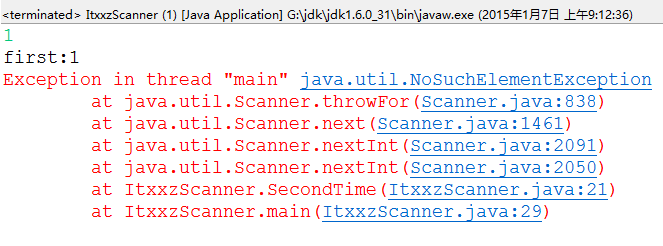轉載自:IT學習者-螃蟹
一個方法A使用了Scanner,在裡面把它關閉了。然後又在方法B裡呼叫方法A之後就不能再用Scanner了Scanner in = new Scanner(System.in);
測試程式碼如下:
import java.util.Scanner; /** * * @author IT學習者-螃蟹 * * */ public class ItxxzScanner { //第一次輸入 public void FistTime (){ Scanner sc = new Scanner (System.in); int first = sc.nextInt(); System.out.println("first:"+first); sc.close(); } //第二次輸入 public void SecondTime(){ Scanner sc = new Scanner (System.in); int second = sc.nextInt(); System.out.println("second:"+second); sc.close(); } //測試入口 public static void main(String arg[]){ ItxxzScanner t = new ItxxzScanner(); t.FistTime(); t.SecondTime(); } }
執行後便丟擲如下異常:

可以看出,在程式碼第29行的時候報錯,丟擲了 java.util.NoSuchElementException 異常,
下面我們來分析一下報錯的原因:
1、在 FistTime(){...} 使用sc.close();進行關閉處理,會把System.in也關閉了
2、當下次在SecondTime(){...}方法中再進行new Scanner (System.in)操作讀取的時候,因為輸入流已經關閉,所以讀取的值就是-1;
3、在Scanner 的readinput方法裡面有以下程式碼:
try { n = source.read(buf); } catch (IOException ioe) { lastException = ioe; n = -1; } if (n == -1) { sourceClosed = true; needInput = false; }
4、因為讀到了-1就設定sourceClosed =true;neepinput=false;
5、在next方法裡面有以下程式碼:
if (needInput) readInput(); else throwFor();
6、當needinput為false,就執行throwFor,因此再看throwFor
skipped = false; if ((sourceClosed) && (position == buf.limit())) throw new NoSuchElementException(); else throw new InputMismatchException();
7、position 是當前讀取的內容在緩衝區中位置,因為讀取的是-1,因此position =0,而buf.limit()也等於0,因此就執行了throw new NoSuchElementException();